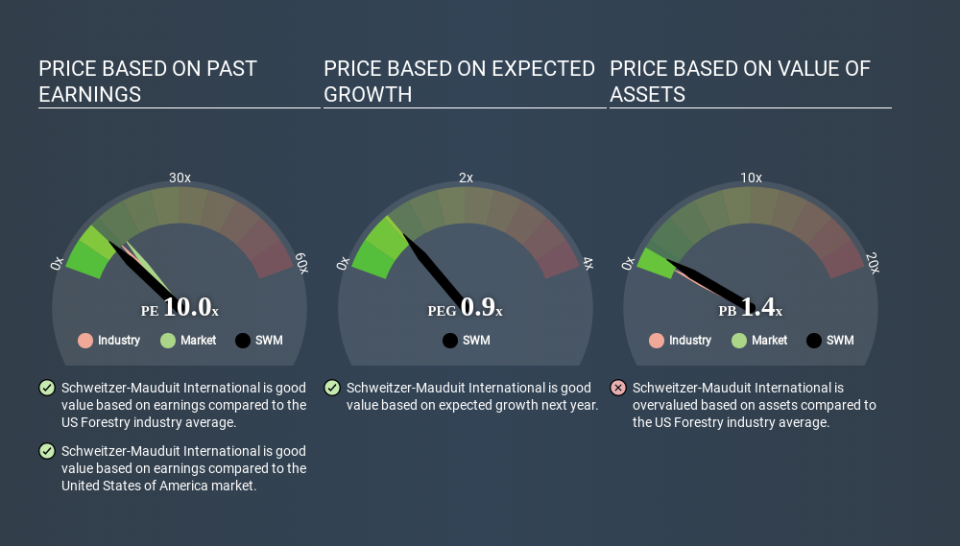Does Schweitzer-Mauduit International, Inc.'s (NYSE:SWM) P/E Ratio Signal A Buying Opportunity?

This article is written for those who want to get better at using price to earnings ratios (P/E ratios). We'll show how you can use Schweitzer-Mauduit International, Inc.'s (NYSE:SWM) P/E ratio to inform your assessment of the investment opportunity. Schweitzer-Mauduit International has a price to earnings ratio of 10.81, based on the last twelve months. That means that at current prices, buyers pay $10.81 for every $1 in trailing yearly profits.
View our latest analysis for Schweitzer-Mauduit International
How Do I Calculate A Price To Earnings Ratio?
The formula for P/E is:
Price to Earnings Ratio = Price per Share ÷ Earnings per Share (EPS)
Or for Schweitzer-Mauduit International:
P/E of 10.81 = $30.040 ÷ $2.780 (Based on the trailing twelve months to December 2019.)
(Note: the above calculation results may not be precise due to rounding.)
Is A High Price-to-Earnings Ratio Good?
A higher P/E ratio means that investors are paying a higher price for each $1 of company earnings. That isn't a good or a bad thing on its own, but a high P/E means that buyers have a higher opinion of the business's prospects, relative to stocks with a lower P/E.
Does Schweitzer-Mauduit International Have A Relatively High Or Low P/E For Its Industry?
We can get an indication of market expectations by looking at the P/E ratio. The image below shows that Schweitzer-Mauduit International has a lower P/E than the average (12.6) P/E for companies in the forestry industry.
Its relatively low P/E ratio indicates that Schweitzer-Mauduit International shareholders think it will struggle to do as well as other companies in its industry classification. Since the market seems unimpressed with Schweitzer-Mauduit International, it's quite possible it could surprise on the upside. If you consider the stock interesting, further research is recommended. For example, I often monitor director buying and selling.
How Growth Rates Impact P/E Ratios
Earnings growth rates have a big influence on P/E ratios. That's because companies that grow earnings per share quickly will rapidly increase the 'E' in the equation. That means even if the current P/E is high, it will reduce over time if the share price stays flat. Then, a lower P/E should attract more buyers, pushing the share price up.
Schweitzer-Mauduit International shrunk earnings per share by 9.9% last year. And EPS is down 1.1% a year, over the last 5 years. So we might expect a relatively low P/E.
Don't Forget: The P/E Does Not Account For Debt or Bank Deposits
One drawback of using a P/E ratio is that it considers market capitalization, but not the balance sheet. That means it doesn't take debt or cash into account. In theory, a company can lower its future P/E ratio by using cash or debt to invest in growth.
Such spending might be good or bad, overall, but the key point here is that you need to look at debt to understand the P/E ratio in context.
Schweitzer-Mauduit International's Balance Sheet
Net debt is 47% of Schweitzer-Mauduit International's market cap. You'd want to be aware of this fact, but it doesn't bother us.
The Verdict On Schweitzer-Mauduit International's P/E Ratio
Schweitzer-Mauduit International trades on a P/E ratio of 10.8, which is below the US market average of 14.0. With only modest debt, it's likely the lack of EPS growth at least partially explains the pessimism implied by the P/E ratio.
Investors should be looking to buy stocks that the market is wrong about. If the reality for a company is not as bad as the P/E ratio indicates, then the share price should increase as the market realizes this. So this free report on the analyst consensus forecasts could help you make a master move on this stock.
But note: Schweitzer-Mauduit International may not be the best stock to buy. So take a peek at this free list of interesting companies with strong recent earnings growth (and a P/E ratio below 20).
If you spot an error that warrants correction, please contact the editor at editorial-team@simplywallst.com. This article by Simply Wall St is general in nature. It does not constitute a recommendation to buy or sell any stock, and does not take account of your objectives, or your financial situation. Simply Wall St has no position in the stocks mentioned.
We aim to bring you long-term focused research analysis driven by fundamental data. Note that our analysis may not factor in the latest price-sensitive company announcements or qualitative material. Thank you for reading.

 Yahoo Finance
Yahoo Finance 
